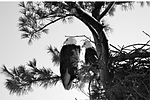Bald Eagle Sighting
Palisades welcomes two new residents. A pair of bald eagles have built a huge nest on an old white pine in Snedens Landing overlooking the Hudson River (see photo.) They can be seen soaring above the water where they hunt for fish, their favorite food.
These two eagles are part of the success story of New York State’s bald eagle restoration project, which began in 1976. Nearly decimated by DDT (banned in 1972) and other pesticides, the number of bald eagles nesting in New York in 1960 was one solitary pair, down from 50 pairs in 1950. And throughout the contiguous United States the bald eagle was in severe decline, mainly due to the thinning of their eggshells from the pesticides, but also from poaching and habitat destruction. Their paltry population put them on the U.S. endangered- species list. The bald eagle was on the road to disaster.
Today, the bald eagle is back in New York, and becoming more numerous every year. In 2010 our national symbol numbered 173 nesting pairs in the state. That year, New York State’s nesting eagles successfully raised approximately 250 eaglets until the young birds were able to fly on their own. The female is the larger of the two birds and five years passes before an immature bald eagle loses its mottled plumage and sports the white head and tail of the adult. Unfortunately, bald eagles are easily spooked by human disturbances, such as housing construction, which is slated to occur on the adjoining lot where our Palisades’ eagles have made their home. Once construction begins, the chances these eagles will abandon their nest is almost certain.
New York State began an official bald eagle restoration project in 1976 by collecting 198 young eaglets in nests, mostly from Alaska. Collected during a 13-year period, they were “hacked,” or hand-reared and released to the wilds of New York. Hacking involves taking young eaglets from their nests and placing them in an artificial and protected nest in the wild; they are then fed and reared by humans until they are ready to fly. By 1989, ten breeding pairs had been established in the state. And now, the latest count may show more than 200 adult nesting pairs. There is even a nesting pair in Inwood Hill Park on Manhattan’s northern tip.
Adding to the bald eagle’s success along the Hudson River in New York is the diversity of more than 200 species of fish that have also returned to the river. The bald eagle feeds on many of these different fish, now thriving in the Hudson.
Aiding in the survival of the bald eagles along the Hudson has been the improvement in the Hudson River’s water quality through the construction of sewage treatment plants and the abatement of chemicals and other pollutants. Further, the protection of an additional one million undeveloped acres in New York during Governor Pataki’s administration has protected some vital eagle habitats in other areas of the state.
According to the State DEC, the bald eagle’s population is now being sustained in New York and throughout the region (along with a number of other birds of prey that have also suffered declines in the past). The challenge is to continue to expand the eagle’s range in areas where it has disappeared, and to protect New York’s breeding bald eagle population from various threats including pollution, habitat destruction and disturbance of nesting areas. Anyone witnessing harassment of eagles or destruction of their nest should call the DEC’s Wildlife Diversity Unit at 518-402-8020.
Eagles can be viewed in a number
of areas in our region:
• The Stateline Lookout at Exit 3 on the
Palisades Parkway.
• On the Piermont Pier.
• Nyack Beach State Park.
• Iona Island Sanctuary in Bear Mountain and
Harriman State Parks.
Don’t forget to bring along binoculars!


